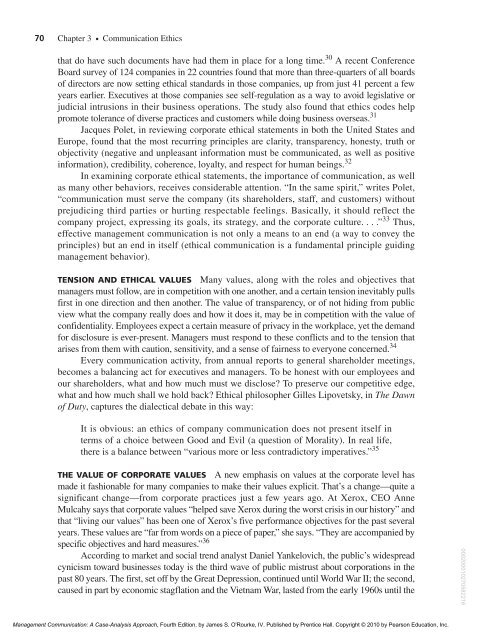MANAGEMENT COMMUNICATION - Pearson Learning Solutions
MANAGEMENT COMMUNICATION - Pearson Learning Solutions
MANAGEMENT COMMUNICATION - Pearson Learning Solutions
Create successful ePaper yourself
Turn your PDF publications into a flip-book with our unique Google optimized e-Paper software.
70 Chapter 3 ● Communication Ethicsthat do have such documents have had them in place for a long time. 30 A recent ConferenceBoard survey of 124 companies in 22 countries found that more than three-quarters of all boardsof directors are now setting ethical standards in those companies, up from just 41 percent a fewyears earlier. Executives at those companies see self-regulation as a way to avoid legislative orjudicial intrusions in their business operations. The study also found that ethics codes helppromote tolerance of diverse practices and customers while doing business overseas. 31Jacques Polet, in reviewing corporate ethical statements in both the United States andEurope, found that the most recurring principles are clarity, transparency, honesty, truth orobjectivity (negative and unpleasant information must be communicated, as well as positiveinformation), credibility, coherence, loyalty, and respect for human beings. 32In examining corporate ethical statements, the importance of communication, as wellas many other behaviors, receives considerable attention. “In the same spirit,” writes Polet,“communication must serve the company (its shareholders, staff, and customers) withoutprejudicing third parties or hurting respectable feelings. Basically, it should reflect thecompany project, expressing its goals, its strategy, and the corporate culture. . . .” 33 Thus,effective management communication is not only a means to an end (a way to convey theprinciples) but an end in itself (ethical communication is a fundamental principle guidingmanagement behavior).TENSION AND ETHICAL VALUES Many values, along with the roles and objectives thatmanagers must follow, are in competition with one another, and a certain tension inevitably pullsfirst in one direction and then another. The value of transparency, or of not hiding from publicview what the company really does and how it does it, may be in competition with the value ofconfidentiality. Employees expect a certain measure of privacy in the workplace, yet the demandfor disclosure is ever-present. Managers must respond to these conflicts and to the tension thatarises from them with caution, sensitivity, and a sense of fairness to everyone concerned. 34Every communication activity, from annual reports to general shareholder meetings,becomes a balancing act for executives and managers. To be honest with our employees andour shareholders, what and how much must we disclose? To preserve our competitive edge,what and how much shall we hold back? Ethical philosopher Gilles Lipovetsky, in The Dawnof Duty, captures the dialectical debate in this way:It is obvious: an ethics of company communication does not present itself interms of a choice between Good and Evil (a question of Morality). In real life,there is a balance between “various more or less contradictory imperatives.” 35THE VALUE OF CORPORATE VALUES A new emphasis on values at the corporate level hasmade it fashionable for many companies to make their values explicit. That’s a change—quite asignificant change—from corporate practices just a few years ago. At Xerox, CEO AnneMulcahy says that corporate values “helped save Xerox during the worst crisis in our history” andthat “living our values” has been one of Xerox’s five performance objectives for the past severalyears. These values are “far from words on a piece of paper,” she says. “They are accompanied byspecific objectives and hard measures.” 36According to market and social trend analyst Daniel Yankelovich, the public’s widespreadcynicism toward businesses today is the third wave of public mistrust about corporations in thepast 80 years. The first, set off by the Great Depression, continued until World War II; the second,caused in part by economic stagflation and the Vietnam War, lasted from the early 1960s until the000200010270582216Management Communication: A Case-Analysis Approach, Fourth Edition, by James S. O'Rourke, IV. Published by Prentice Hall. Copyright © 2010 by <strong>Pearson</strong> Education, Inc.

















